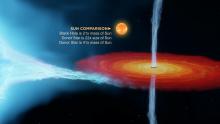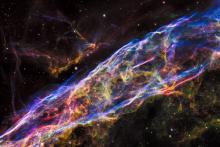Listen to today's episode of StarDate on the web the same day it airs in high-quality streaming audio without any extra ads or announcements. Choose a $8 one-month pass, or listen every day for a year for just $30.
You are here
Northern Cross
One of the most prominent constellations of summer transforms itself when the weather turns cold. It’s still the same pattern of stars, but because of the different viewing angle, it’s often seen as a different picture.
The constellation is Cygnus, the swan. During the summer months, it soars high across the evening sky. Its brightest stars form a pattern that looks like a graceful bird. Its long body lines up roughly parallel to the horizon, with its wings extending above and below the body.
By this time of year, though, Cygnus is in the western sky during the evening hours. Its bill points downward. And its wings are almost parallel to the horizon, as though the swan is plunging toward the ground. Seen at this angle, it more closely resembles the constellation’s nickname — the Northern Cross.
The star at the top of the cross represents the tail of the swan — blue-white Deneb. It’s one of the biggest, brightest, hottest stars in our region of the galaxy. Although there’s some wiggle room in the distance, the star probably is close to 1500 light-years away. That means the light we see from Deneb tonight has been crossing the Milky Way Galaxy for a millennium and a half — a long-distance trek from a star that anchors two star patterns.
Look for the swan in its alternate guise — the Northern Cross — standing well up in the western sky as darkness falls. It perches directly atop the horizon in mid-evening.
Script by Damond Benningfield






